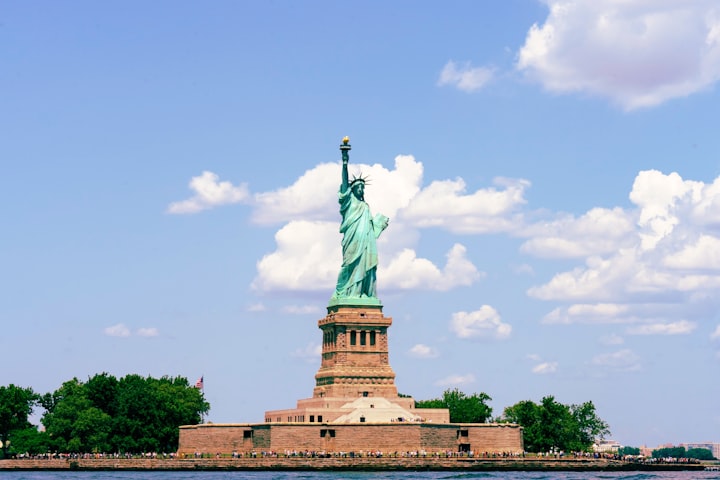An Immigrant Nation
The New Colossus and American Immigration

To the impoverished immigrant, America must have seemed like a poor man's utopia, and the Statue of Liberty, completed in 1884, was a potent symbol of their hopes and dreams. Inscribed in the base of this distinguished landmark is "The New Colossus," a poem by Emma Lazarus, herself the child of Portuguese immigrants. In this poem, she refers to the statue, and indeed the entire nation, as the "Mother of Exiles." This imagery is appropriate because the first Americans were, in large part, political and religious exiles.
As a distant colony of the British Empire, the "new world" offered a refuge far away from the relative bondage of monarchial rule, where settlers could worship freely and determine the course of their own lives. However, British interference eventually led to massive insurrection and the creation of an unprecedented democratic nation. As America grew from infancy into adolescence, it became a successful player on the world stage, and the freedoms enjoyed by its citizens became the envy of people worldwide.
America soon became a place of mythical promise. For the price of passage across the Atlantic, one could open the door to a land of milk and honey. The poor and impoverished often carried a bleary-eyed optimism and a foolish notion that tomorrow would bring success or the promise of it. This may be what America represented to the downtrodden immigrant.
Unfortunately, the reality of America was vastly different from what many immigrants imagined. While there was a wealth of opportunity to be found in this fairly young nation, there were also numerous obstacles standing in the way of success. Late 19th-century America was a nation where human rights were often violated, and many immigrants suffered greater abuses in the United States than they did in their native countries. For better or worse, the immigrant experience became etched into American memory, and the diversity of immigrants came to define America as a socially progressive nation.
Most American schoolchildren can recite the story of the Mayflower and the Pilgrims who landed at Plymouth Rock. While the word "pilgrim" is often used to describe a particular group of American settlers, it is more commonly used to describe anyone on a religious journey, and the first settlers of the New World were indeed on such a journey. When Emma Lazarus called Bartholdi's statue the "Mother of Exiles," she may have been referring to the countless British exiles who had left England in search of religious and political freedom. The "Pilgrims," for example, were Separatists from the Church of England, and they were soon joined by other religious dissidents in search of similar liberties. However, freedom had its limits as the colonies were under British control, and British rule was often brutal.
In the hands of the Statue of Liberty, there are a tablet and a torch. According to "The New Colossus," the flame of the torch is "imprisoned lightning." This phrase describes a certain level of volatility. While the United States symbolically guides the world like a burning flame, it is also like a lightning bolt, an uncontrollable force of nature that refuses to be subjugated or controlled. This unwillingness to bow to foreign rule was established early on when American colonists announced their separation from the British Empire.
The Declaration of Independence was written in response to the "abuses and usurpations" of the British monarchy. The colonists were not only overtaxed but also lacked representation in Parliament, leaving them no recourse against taxation. The British exerted control in a land where their control was limited, and the American colonists grew weary of imperial rule. Following the Declaration of Independence, the American colonies engaged in a massive power struggle with the most powerful empire in the world and eventually won their freedom.
The Declaration of Independence briefly outlines the "inalienable" rights of all Americans: life, liberty, and the pursuit of happiness. However, history has shown that while these rights may seem morally and philosophically inalienable, they are socially and politically ambiguous. The definitions of each right can be easily manipulated to fit any social and political agenda. This was never more apparent than during the period of American slavery.
Although African slaves did not arrive in North America by their own volition, they represented a massive influx and should not be excluded from discussions of American immigration. The 19th century witnessed a monumental increase in the number of slaves living in the United States. The slave population grew from nearly nine hundred thousand at the beginning of the century to nearly four million by the era of emancipation.
The fact that slavery no longer endures as an institution says much about the progress of the nation. In her poem, Emma Lazarus alludes to the Colossus of Rhodes, one of the wonders of the ancient world, for contrast. The giant statue was said to have straddled the sea walls of the man-made harbor at Rhodes, a bustling port city of the Roman Empire. Slavery in Roman society was legally justified by defining slaves as property, allowing the practice to flourish. Rhodes likely participated in the slave trade, making Lazarus' contrast of the Statue of Liberty with the Colossus all the more appropriate.
By the time the Statue of Liberty was erected in New York Harbor, the United States had seen an end to legal slave trading and the permanent abolition of slavery through the Emancipation Proclamation in 1863. The abolition of slavery represented a significant social leap forward, considering its long history observed by many countries. However, the descendants of African slaves continued to struggle for equal rights well into the 20th century. The nation of exiles had created exiles of its own and would continue to do so.
In the mid- to late-19th century, the United States experienced an increase in European immigration. European immigrants were predominantly members of the lower classes. Some immigrants fled religious and political persecution, while others sought a better life and opportunities to uplift themselves and their families from destitution. In "The New Colossus," the Statue of Liberty pleads for the impoverished, the exhausted, the "wretched refuse... the homeless, [and] the tempest-tost" to leave Europe and find providence in the United States. However, this passage also reflects the political struggle in which Emma Lazarus engaged before the statue's completion. As a Sephardic Jew and the child of immigrants, Lazarus became an advocate for Jewish refugees. Through her various works, she brought attention to the rise of European anti-Semitism and gained the necessary social and political backing to support European Jews fleeing their homelands. The arrival of countless Jewish immigrants was only a fraction of the total number of immigrant arrivals in the 19th century.
Census estimates from the 19th century indicate that German immigration exceeded five and a half million by the end of the century, while Irish immigration rose to around four and a half million. The number of Irish immigrants dramatically increased in the wake of the Irish Potato Famine, which claimed more than a million lives. New York, home to the majority of German immigrants, also experienced a large-scale influx of French and Russian immigrants between 1850 and 1860. Italian immigration reached similar numbers, but their significant ingress occurred in the latter part of the century.
While some immigrants found their place and thrived, not every immigrant had the same experience. The Irish, for example, faced intense discrimination and were often perceived as lazy and prone to alcoholism. Due to nativism, a resistance movement against immigration, many new Irish arrivals suffered more discrimination than they did in Ireland. Nativism took various forms and fueled anti-immigration movements, notably the anti-Catholic and anti-Chinese movements.
The Chinese faced even greater exclusion and discrimination. In 1882, two years before the completion of the Statue of Liberty, the Chinese Exclusion Act was passed, imposing a moratorium on Chinese immigration. It would take sixty years before Chinese immigrants could freely enter the United States. Unfortunately, the Chinese experience is not unique in American history.
Immigration exclusion has been a longstanding issue in the United States. The 1875 Immigration Act was the first legislation to exclude certain groups from immigrating. Historically, the Supreme Court has upheld laws excluding naturalization based on racial backgrounds. In the past, racial preferences influenced immigration policies, as seen in cases such as United States v. Thind (1923) and Ozawa v. the United States (1922). These cases determined that individuals of Indian and Japanese descent could not be classified as "white" under naturalization statutes from the 1790s. Today, the question of immigrant exclusion continues with the issue of Mexican immigration to America.
Mexican migrant workers form a significant part of the American agricultural workforce, particularly in the American Southwest. Many Mexicans enter the country illegally due to difficulties in obtaining permission to work or live in the United States. American lawmakers and citizens have raised concerns about Mexican immigration, claiming it harms the American economy. One complaint suggests that because Mexicans send their earnings back to their families in Mexico, the American economy suffers from the loss of recirculated earnings. However, this overlooks the interdependency between the American and Mexican economies. The American economy relies on Mexican labor, while the Mexican economy relies on American industries for goods and services.
Many criticisms of Mexican immigration are based on misinformation or incomplete information. During times of economic crisis, people tend to look for scapegoats. Mexican scapegoating is not a new occurrence. During the Great Depression, many naturalized Mexican-Americans were deported to Mexico as a means to protect social programs from being exploited. This is similar to arguments raised today regarding strict immigration practices.
In a passage from "The New Colossus," Emma Lazarus describes Lady Liberty's "beacon-hand" glowing with worldwide welcome. However, the truth is that the United States is more welcoming to certain groups than others. Emma Lazarus died in 1887 at the age of 38, just long enough to witness the enactment of the Chinese Exclusion Act. While there is no record of her public opinion on this miscarriage of liberty, it can be reasonably assumed that she, as a champion of exiles, would have opposed such exclusionary measures.
Through her literary works, Emma Lazarus advocated for Jewish Europeans suffering from anti-Semitism and pogroms. She believed in human rights and equal opportunities, as did the founding fathers of the United States, despite many of them owning slaves. However, it is the message conveyed in her writings that matters. "The New Colossus" delivers a powerful message, reflecting not the absolute truth about America, but the vision that America and its most potent symbol, the Statue of Liberty, can inspire.

Matthew Devlin (he/him) is an author and historian living in Myrtle Beach, South Carolina.
About the Creator
Mack Devlin
Writer, educator, and follower of Christ. Passionate about social justice. Living with a disability has taught me that knowledge is strength.
We are curators of emotions, explorers of the human psyche, and custodians of the narrative.






Comments
There are no comments for this story
Be the first to respond and start the conversation.